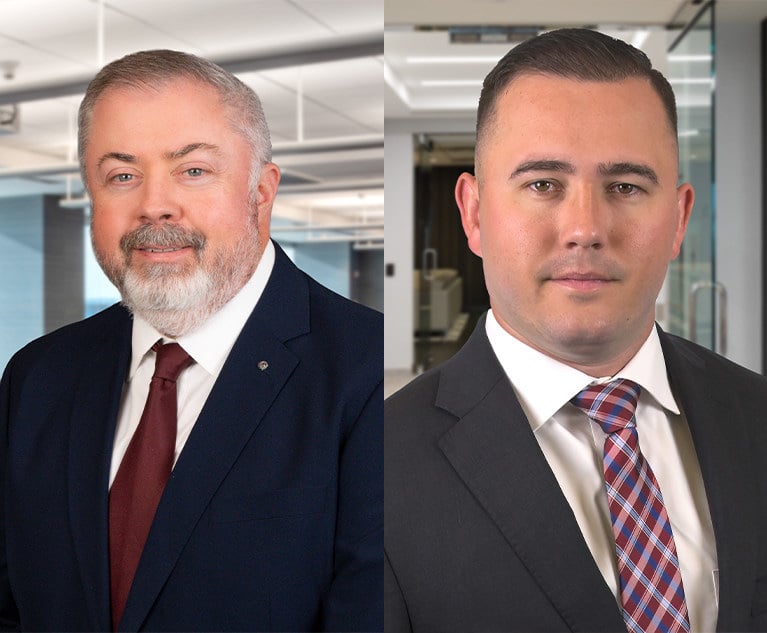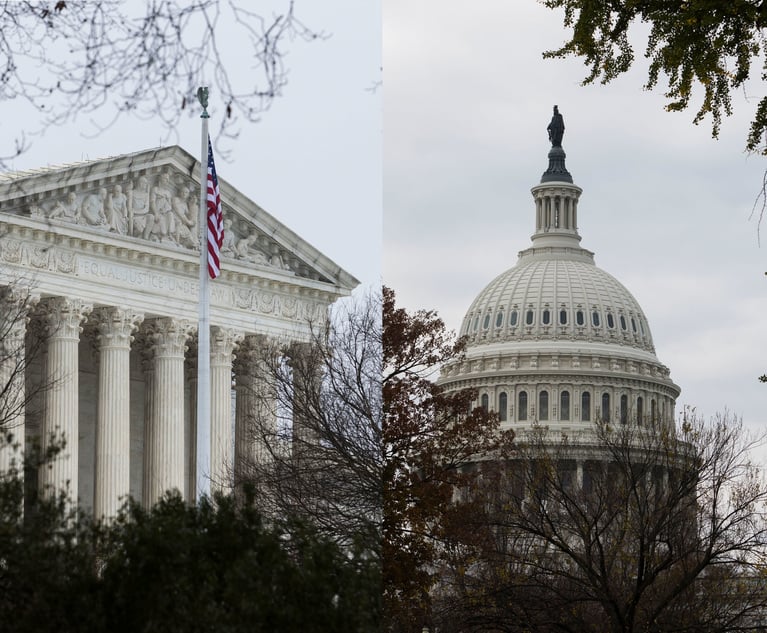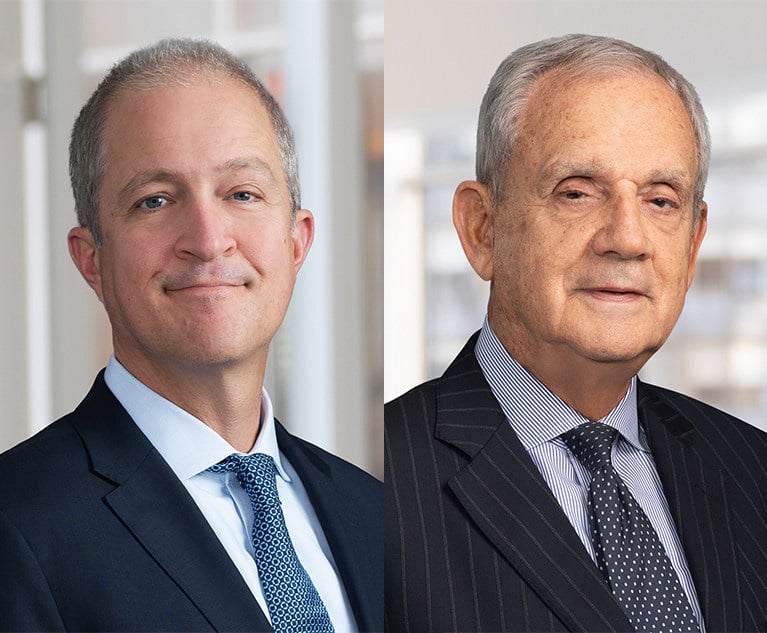 Patrick M. Connors
Patrick M. ConnorsProblems to Avoid in E-Filed Actions
In his New York Practice column, Patrick M. Connors discusses cases that tackle the various issues which have developed alongside the growth of e-filing in New York state courts. He writes that lawyers should be aware of the pitfalls that can occur while dipping their toes into the e-filing waters.
July 26, 2019 at 12:30 PM
10 minute read
The Summer of 2019 is now upon us. Yankees fans are enjoying a somewhat comfortable lead in the American League East and a few pleasant surprises from players stepping in to starting roles. Mets fans are reading Tolstoy, attending the ballet, and following the early start to the Saratoga Race Course meeting. As we enjoy all of the pleasures that The Empire State offers and recharge our batteries during this special season, it's also important to keep one eye on developments in the law.
The Growth of E-filing. It took quite a long time for e-filing to take hold in New York state courts, but it is now picking up momentum. As of this writing, there have been 2,029,976 e-filed actions and 28,411,419 documents have been e-filed in those actions. The New York State Courts Electronic Filing System (NYSCEF) boasts 87,478 registered attorney users and 11,838 pro se litigants have also participated in e-filing. Of the 62 counties in New York state, 47 have implemented an e-filing program to date.
Under the May 31, 2019 administrative order of Chief Administrative Judge Marks (AO/137/19), e-filing is now mandatory in 36 counties in various categories of actions. Those counties and 11 additional counties have consensual or voluntary e-filing programs, which allow parties to consent to e-filing in various categories of actions. Mandatory and consensual e-filing is also up and running in the Surrogate's Court, the Court of Claims, and the New York City Civil Court. See Siegel & Connors, New York Practice §63A (6th ed., 2018) (discussing status of e-filing in New York state courts). If you have not yet participated in an e-filed action in the New York state court system, you are likely in the minority.
The case law addressing problems that have occurred in e-filed actions is now starting to accumulate and lawyers should be aware of the pitfalls that can occur while dipping their toes into these waters. The NYSCEF website should also be consulted, as it offers helpful guidance in the way of forms and training. Statewide NYSCEF Coordinator Jeffrey Carucci and the crackerjack staff at the NYSCEF Resource Center provide invaluable assistance to those encountering problems while swimming in the deep end of the e-filing pool.
CPLR 2103's Add-Ons Not Available in E-filed Actions. CPLR 2103(b) contains the provisions granting the recipient of an interlocutory paper additional days to perform a procedural act when the paper is served by mail or an overnight delivery service and the time to perform the act runs from the service of the paper. See Siegel & Connors, New York Practice §202. The additional times are five or six days when the paper is served by mail, see CPLR 2103(b)(2), but only one day if it is served through an overnight delivery service. See CPLR 2103(b)(6). These provisions implicitly recognize that the service of a paper is deemed complete upon posting, and not actual receipt of the paper, and compensate for the delay in mail delivery.
These add-ons have ubiquitous application in actions involving hard copy filings, but are rarely available in e-filed actions where service of an interlocutory paper is normally made simultaneously with the electronic filing of the document, rather than by mail. See 22 N.Y.C.R.R. §202.5-b(f)(2)(ii) (rule for consensual e-filing program); 22 N.Y.C.R.R. §202.5-bb(a)(1) (noting that rules for consensual e-filing program govern in actions subject to mandatory e-filing, unless the rules for mandatory e-filing provide otherwise). There is no corresponding delay in receipt of an interlocutory paper that is served in an e-filed action because “the NYSCEF site shall automatically transmit electronic notification to all” parties in the action via email. 22 N.Y.C.R.R. §202.5-b(f)(2)(ii). “[T]he electronic transmission of the notification shall constitute service of the document on the e-mail service addresses identified therein.” Id.
Lawyers participating in e-filed actions must keep these rules in mind when calendaring matters to avoid letting important time periods expire. Some recent case law demonstrates the problem.
Motion to Change Venue in E-filed Action Ruled Untimely. The county in which an action is venued can have a huge impact on the value of the case and defendants who want to contest a plaintiff's choice of venue must act promptly. See Siegel & Connors, New York Practice §123. When D contends that P has laid venue in an improper county and seeks to change it to a proper county as a matter of right, D must follow the special “demand” procedure of CPLR 511(b). Under this procedure, D must serve on P a written demand that venue be changed to the county D specifies as proper. If P contests D's demand, or does not respond to it, D must move to change venue within 15 days from service of its demand. See CPLR 511(b).
In Simon v. Usher, 17 N.Y.3d 625 (2011), the Court of Appeals held that the five-day extension in CPLR 2103(b)(2) is afforded to a party moving to change venue under CPLR 511(b) and ruled that a motion made 20 days after the service of the demand to change venue was timely. In Simon, the demand was served by mail, but more recently in Woodward v. Millbrook Ventures, 148 A.D.3d 658 (1st Dep't 2017), a consensual e-filing case, the demand was deemed served when it was electronically filed and that meant the defendants would not be able to rely on CPLR 2103(b)(2)'s five-day add-on. Therefore, the First Department ruled that defendants' motion to change venue, made 17 days after service of the demand to change venue, was untimely. The fact that defendants also served their demand via regular mail did not afford them the five-day extension in CPLR 2103(b)(2). “Because they consented to participate in Supreme Court's e-filing system,” the court held that “defendants were bound by the applicable rules governing service” in e-filed actions.
Motions to Reargue in E-Filed Actions Ruled Untimely. In Mazario v. Snitow Kanfer Holtzer & Millus, 2018 WL 6739091 (Sup. Ct., New York County 2018), plaintiffs moved to reargue a motion decided in an order dated May 24, 2018, which was served by defendants with notice of entry by e-filing on May 29, 2018. Plaintiffs moved to reargue on July 3, 2018, within 35 days after service of the order with notice of entry. As noted above, CPLR 2103(b)(2)'s five-day add-on generally does not apply in e-filed actions because the interlocutory papers are served via the NYSCEF site, and not via regular mail. Therefore, the motion was five days late. See CPLR 2221(d)(3) (motion to reargue must be made within 30 days after service of a copy of order determining prior motion and written notice of entry); Siegel & Connors, New York Practice §254. The court noted that the fact that defendants subsequently mailed the order with notice of entry after e-filing it did not change the result.
Similarly, in Nolte v. Bridgestone Assocs., 2018 WL 3729562 (Sup. Ct., New York County 2018), the court ruled that a motion for reargument was untimely by five days in an action subject to mandatory e-filing. The fact “[t]hat plaintiff also elected to serve a copy of the notice of entry by regular mail did not extend defendant's deadline to file a motion for reargument” under CPLR 2103(b)(2).
Hard Copy Service in an E-filed Action? The mischief in cases like Mazario and Nolte is likely created by 22 N.Y.C.R.R. §202.5-b(h)(2), which allows a party, as an alternative to e-filing and electronically serving an order or judgment with notice of its entry, to “serve a copy of the order or judgment and written notice of its entry in hard copy by any method set forth in CPLR 2103(b)(1) to (6).” If a party chooses to serve a hard copy of the order or judgment, proof of that service must be filed electronically. See 22 N.Y.C.R.R. §202.5-b(f)(2)(ii). Similarly, 22 N.Y.C.R.R. §202.5-b(f)(2)(ii) permits a party in an e-filed action to “utilize other service methods permitted by the CPLR provided that, if one of such other methods is used, proof of that service shall be filed electronically.”
These provisions seemingly permit an odd opt-out of sorts from the general rule requiring a party to electronically serve documents in an e-filed action. The decisions in Mazario and Nolte appear to take the position that if, for example, a party serves an order or judgment with notice of entry both electronically and through the U.S. Postal System, the latter service will not afford five additional days to perform a procedural act. But not all courts have agreed. See Global Custom Integrations v. JDP Wholesale Enterprises, 40 Misc.3d 909 (Sup. Ct., Westchester County 2013) (holding that when service is made by first-class mail after service by e-filing, the five-day extension to respond in CPLR 2103(b)(2) applied).
E-filing of Notice of Service on One Party Does Not Constitute Service on Other Parties. In JBBNY v. Dedvukaj, 171 A.D.3d 898 (2d Dep't 2019), an e-filed mortgage foreclosure action, defendants unsuccessfully moved to dismiss the complaint under CPLR 3211(a). The plaintiff served the order denying the motion with notice of entry on D-1 by regular mail. On the same day, the plaintiff e-filed the notice of entry of the order and proof of mailing on D-1 on the NYSCEF site. A “confirmation notice” was emailed to counsel for D-2 and D-3 indicating that these documents had been e-filed. Plaintiff did not, however, independently serve a copy of the order with notice of entry on D-2 or D-3.
The Second Department noted that pursuant to 22 N.Y.C.R.R. §202.5-b(f)(2)(ii), a party may serve an interlocutory document upon another party by e-filing the document, whereupon “the NYSCEF site shall automatically transmit electronic notification to all e-mail service addresses in such action.” The court also quoted the additional language from the same rule, which provides that “the electronic transmission of the notification shall constitute service of the document on the e-mail service addresses identified therein.” As the JBBNY court noted, however, this rule also contains an exception for the service of orders with notice of entry via e-filing, discussed above, which allows for service via hard copy.
Section 202.5-b(h)(2) states that if a party opts to serve an order with notice of entry in hard copy pursuant to CPLR 2103(b), “and a copy of the order or judgment and notice of its entry and proof of such hard copy service are thereafter filed with the NYSCEF site, transmission by NYSCEF of notification of receipt of those documents shall not constitute additional service of the notice of entry on the parties to whom the notification is sent.” (emphasis added). Applying this rule in JBBNY, the Second Department ruled that “the transmission by NYSCEF of the confirmation notice of receipt of the documents showing that the plaintiff served [D-1] with notice of entry did not constitute service upon [D-2 and D-3].”
The failure to make proper service of the order with notice of entry on D-2 and D-3 meant that their time to serve an answer under CPLR 3211(f) never started to run. See Siegel & Connors, New York Practice §277. Therefore, the Second Department reversed the Supreme Court's order finding D-2 and D-3 in default and granted that portion of the defendants' cross-motion to compel plaintiff to accept their answer.
Patrick M. Connors is the Albert and Angela Farone Distinguished Professor in New York Civil Practice at Albany Law School. He is the author of Siegel & Connors, New York Practice (Thomson Reuters 6th ed. 2018). The July 2019 Supplement is now available.
This content has been archived. It is available through our partners, LexisNexis® and Bloomberg Law.
To view this content, please continue to their sites.
Not a Lexis Subscriber?
Subscribe Now
Not a Bloomberg Law Subscriber?
Subscribe Now
NOT FOR REPRINT
© 2025 ALM Global, LLC, All Rights Reserved. Request academic re-use from www.copyright.com. All other uses, submit a request to [email protected]. For more information visit Asset & Logo Licensing.
You Might Like
View All
Lessons Learned From the Pager Attack: the Law of War, Warfighting, and the Weaponization of the Supply Chain
8 minute read
Roberts Calls Court's Relationship With Congress 'Strained.' Who's to Blame?


Preemptive Litigation: A Potential Approach for a Precise Situation
13 minute readTrending Stories
- 1Decision of the Day: Uber Cannot Be Held Vicariously Liable for Driver's Alleged Negligent Conduct
- 2TikTok Law and TikTok Politics
- 3California Supreme Court Vacates Murder Conviction in Infant Abuse Case
- 4New York’s Proposed Legislation Restraining Transfer of Real Property
- 5Withers Hires Lawyers, Staff From LA Trusts and Estates Boutique
Who Got The Work
Michael G. Bongiorno, Andrew Scott Dulberg and Elizabeth E. Driscoll from Wilmer Cutler Pickering Hale and Dorr have stepped in to represent Symbotic Inc., an A.I.-enabled technology platform that focuses on increasing supply chain efficiency, and other defendants in a pending shareholder derivative lawsuit. The case, filed Oct. 2 in Massachusetts District Court by the Brown Law Firm on behalf of Stephen Austen, accuses certain officers and directors of misleading investors in regard to Symbotic's potential for margin growth by failing to disclose that the company was not equipped to timely deploy its systems or manage expenses through project delays. The case, assigned to U.S. District Judge Nathaniel M. Gorton, is 1:24-cv-12522, Austen v. Cohen et al.
Who Got The Work
Edmund Polubinski and Marie Killmond of Davis Polk & Wardwell have entered appearances for data platform software development company MongoDB and other defendants in a pending shareholder derivative lawsuit. The action, filed Oct. 7 in New York Southern District Court by the Brown Law Firm, accuses the company's directors and/or officers of falsely expressing confidence in the company’s restructuring of its sales incentive plan and downplaying the severity of decreases in its upfront commitments. The case is 1:24-cv-07594, Roy v. Ittycheria et al.
Who Got The Work
Amy O. Bruchs and Kurt F. Ellison of Michael Best & Friedrich have entered appearances for Epic Systems Corp. in a pending employment discrimination lawsuit. The suit was filed Sept. 7 in Wisconsin Western District Court by Levine Eisberner LLC and Siri & Glimstad on behalf of a project manager who claims that he was wrongfully terminated after applying for a religious exemption to the defendant's COVID-19 vaccine mandate. The case, assigned to U.S. Magistrate Judge Anita Marie Boor, is 3:24-cv-00630, Secker, Nathan v. Epic Systems Corporation.
Who Got The Work
David X. Sullivan, Thomas J. Finn and Gregory A. Hall from McCarter & English have entered appearances for Sunrun Installation Services in a pending civil rights lawsuit. The complaint was filed Sept. 4 in Connecticut District Court by attorney Robert M. Berke on behalf of former employee George Edward Steins, who was arrested and charged with employing an unregistered home improvement salesperson. The complaint alleges that had Sunrun informed the Connecticut Department of Consumer Protection that the plaintiff's employment had ended in 2017 and that he no longer held Sunrun's home improvement contractor license, he would not have been hit with charges, which were dismissed in May 2024. The case, assigned to U.S. District Judge Jeffrey A. Meyer, is 3:24-cv-01423, Steins v. Sunrun, Inc. et al.
Who Got The Work
Greenberg Traurig shareholder Joshua L. Raskin has entered an appearance for boohoo.com UK Ltd. in a pending patent infringement lawsuit. The suit, filed Sept. 3 in Texas Eastern District Court by Rozier Hardt McDonough on behalf of Alto Dynamics, asserts five patents related to an online shopping platform. The case, assigned to U.S. District Judge Rodney Gilstrap, is 2:24-cv-00719, Alto Dynamics, LLC v. boohoo.com UK Limited.
Featured Firms
Law Offices of Gary Martin Hays & Associates, P.C.
(470) 294-1674
Law Offices of Mark E. Salomone
(857) 444-6468
Smith & Hassler
(713) 739-1250






